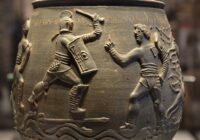
The figure depicts a gladiator of the secutor class, a heavily armed fighter who carried a heavy rectangular shield and short sword. He wore a full-coverage helmet with two small openings to see through, a manica (arm guard) on his right arm and an ocrea (greave) on his left leg. The secutor was fielded again the retiarius who fought bareheaded and unshielded with a trident, net and dagger. This particular secutor is left-handed. Left-handedness was considered unlucky, so it is a distinguishing feature for a gladiator and may indicate the figure is depicting a specific fighter.

Dr Frances McIntosh, English Heritage’s Collections Curator for Hadrian’s Wall and the North East, said, ‘It is rare to find a piece of gladiator memorabilia in Britain and to find such a well preserved and interesting piece is particularly remarkable.
‘Despite being enslaved and socially outcast due to their profession, gladiators could become huge celebrities. Gladiators and the ‘spectacles’ were an integral part of Roman cultural life, taking place all across the Roman Empire. The phenomenon inspired the creation of sporting memorabilia, such as decorated ceramics and glass cups, lamps and figurines.
‘Gladiators had sex appeal and there are cases of high-status Roman women falling ‘in love’ with these lowly fighters, despite the vast social difference. This beautifully made knife handle is a testament to how pervasive this celebrity culture was, reaching all the way to Hadrian’s Wall at the very edge of the Roman Empire.”
The Tyne knife handle was finely cast and is a high-quality piece. It not mass-produced. It was likely a commissioned piece, and if it fell into the river by accident, the loss would have been much regretted.
The handle will go on display at Corbridge Roman Town in 2025 accompanied by other artifacts discovered in the River Tyne.
* This article was originally published here








No comments:
Post a Comment